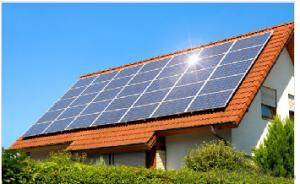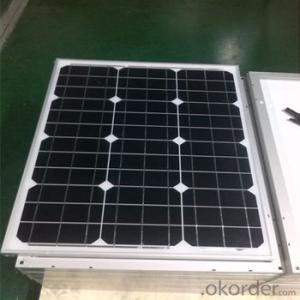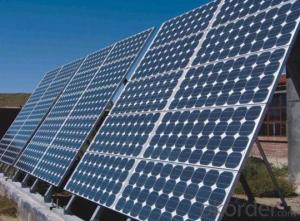Solar Panels from CNBM
- Loading Port:
- China main port
- Payment Terms:
- TT OR LC
- Min Order Qty:
- 1 pc
- Supply Capability:
- 10000000 pc/month
OKorder Service Pledge
OKorder Financial Service
You Might Also Like
Product Description:
Solar Module
ABOUT YINGLI GREEN ENERGY
Yingli Green Energy Holding Company Limited (NYSE: YGE) is one of
the world’s largest fully vertically integrated PV manufacturers, which
markets its products under the brand “Yingli Solar“. With over 7.0GW
of modules installed globally, we are a leading solar energy company
built upon proven product reliability and sustainable performance. We
are the fi rst renewable energy company and the fi rst Chinese company
to sponsor the FIFA World CupTM.
PERFORMANCE
- High effi ciency, multicrystalline silicon solar cells with high transmission
and textured glass deliver a module effi ciency of up to 16.0%,
minimizing installation costs and maximizing the kWh output of your
system per unit area.
- Tight positive power tolerance of 0W to +5W ensures you receive
modules at or above nameplate power and contributes to minimizing
module mismatch losses leading to improved system yield.
- Top ranking in the “TÜV Rheinland Energy Yield Test” and the
“PHOTON Test” demonstrates high performance and annual energy
production.
RELIABILITY
- Tests by independent laboratories prove that Yingli Solar modules:
Fully conform to certifi cation and regulatory standards.
Withstand wind loads of up to 2.4kPa and snow loads of up to
5.4kPa, confi rming mechanical stability.
Successfully endure ammonia and salt-mist exposure at the highest
severity level, ensuring their performance in adverse conditions.
- Manufacturing facility certifi ed by TÜV Rheinland to ISO 9001:2008,
ISO 14001:2004 and BS OHSAS 18001:2007.
WARRANTIES
- 10-year limited product warranty1.
- Limited power warranty1: 10 years at 91.2% of the minimal rated power
output, 25 years at 80.7% of the minimal rated power output.
1In compliance with our Warranty Terms and Conditions.
QUALIFICATIONS & CERTIFICATES
IEC 61215, IEC 61730, MCS, CE, ISO 9001:2008, ISO 14001:2004, BS OHSAS
18001:2007, PV Cycle, SA 8000
ELECTRICAL PERFORMANCE
Electrical parameters at Standard Test Conditions (STC)
Module type YLxxxP-29b (xxx=Pmax)
Power output Pmax W 260 255 250 245 240
Power output tolerances ΔPmax W 0 / + 5
Module effi ciency ηm % 16.0 15.7 15.4 15.1 14.8
Voltage at Pmax Vmpp V 30.3 30.0 29.8 29.6 29.3
Current at Pmax Impp A 8.59 8.49 8.39 8.28 8.18
Open-circuit voltage Voc V 37.7 37.7 37.6 37.5 37.5
Short-circuit current Isc A 9.09 9.01 8.92 8.83 8.75
Electrical parameters at Nominal Operating Cell Temperature (NOCT)
Power output Pmax W 189.7 186.0 182.4 178.7 175.1
Voltage at Pmax Vmpp V 27.6 27.4 27.2 27.0 26.8
Current at Pmax Impp A 6.87 6.79 6.71 6.62 6.54
Open-circuit voltage Voc V 34.8 34.8 34.7 34.6 34.6
Short-circuit current Isc A 7.35 7.28 7.21 7.14 7.07
STC: 1000W/m2 irradiance, 25°C cell temperature, AM1.5g spectrum according to EN 60904-3.
Average relative effi ciency reduction of 3.3% at 200W/m2 according to EN 60904-1.
NOCT: open-circuit module operation temperature at 800W/m2 irradiance, 20°C ambient temperature, 1m/s wind speed.
OPERATING CONDITIONS
Max. system voltage 1000VDC
Max. series fuse rating 15A
Limiting reverse current 15A
Operating temperature range -40°C to 85°C
Max. static load, front (e.g., snow) 5400Pa
Max. static load, back (e.g., wind) 2400Pa
Max. hailstone impact (diameter / velocity) 25mm / 23m/s
CONSTRUCTION MATERIALS
Front cover (material / thickness) low-iron tempered glass / 3.2mm
Cell (quantity / material / dimensions /
number of busbars)
60 / multicrystalline silicon / 156mm x 156mm / 2 or 3
Encapsulant (material) ethylene vinyl acetate (EVA)
Frame (material / color / anodization color /
edge sealing) anodized aluminum alloy / silver / clear / silicone or tape
Junction box (protection degree) ≥ IP65
Cable (length / cross-sectional area) 1000mm / 4mm2
Plug connector
(type / protection degree) MC4 / IP67 or YT08-1 / IP67 or Amphenol H4 / IP68
PACKAGING SPECIFICATIONS
Number of modules per pallet 29
Number of pallets per 40' container 28
Packaging box dimensions
(L / W / H) 1700mm / 1135mm / 1165mm
Box weight 568kg
Unit: mm
• Due to continuous innovation, research and product improvement, the specifi cations in this product information sheet are subject to change
without prior notice. The specifi cations may deviate slightly and are not guaranteed.
• The data do not refer to a single module and they are not part of the offer, they only serve for comparison to different module types
- Q:I don't see much solar panels on people's houses where I live. I got a long time to go before doing so but I was planning on buying a few solar panels when I retire in the far future. In your opinion, is such an investment worth it? Would you buy them? I realize they are very expensive hence why I said when I retire. Thanks for your opinion
- Solar power is still an expensive way to purchase power, as of 2007, it was 38 cents per kwh while the cost of power from coal is 0.6 cents per kwh. Of course regulations have prevented new coal power stations from being built so it's really natural gas power stations at 5 cents a kwh that solar has to compete with. Solar is dropping in price but the best you can hope for is for it to reach parity with natural gas someday soon and it hasn't yet. The other issue is that you pay up front for solar power which as any economist will tell you is even more expensive and involves greater risks. However, as part of a strategy to become as self reliant as possible when you retire and have a fixed income, it's a reasonable prospect, not only will the technology become less expensive by then but at that point, fixing the price of the energy costs is more valuable than the cost of the energy. Focusing on personal finance and learning how to invest which very few people know how to do is more important right now. When you retire, hopefully you can afford to build a passive solar home with photovoltaic solar panels and wind turbines but still on the grid for efficient net metering and with a greenhouse where you can grow the staples that you need and perhaps even some biodiesel for your google driven car. Having a reasonable portfolio is really the only way to achieve that goal.
- Q:Can solar panels increase the value of my property?
- Yes, solar panels can increase the value of your property. Installing solar panels can be seen as a desirable feature by potential buyers, as it offers the benefit of reduced energy costs and environmental sustainability. Studies have shown that homes with solar panels tend to sell for higher prices compared to similar homes without them. Additionally, solar panels may also attract more buyers, increasing the demand and overall value of your property.
- Q:Is there a cheaper way on how to make your own solar panels ? Can someone share their real life experience ? Thank you.
- I did my own solar panel at a fraction of a commercial one by diy manual. I think some of the important criteria to consider about these diy manual are : . is it proven by many of its readers ? 2. How easy to follow the manual ? 3. Any video showing the steps to assemble your own panel ? 4. Any after sales support ? You can cut down your electricity bill on some small appliances like your labtop or fans, but not practical on heavy duty appliances like air-cond, etc.
- Q:Okay so.. if light deflect the light of the sun and black absorbs it, then aren't solar panels just absorbing more light, sun and heat into our atmosphere? Wouldn't this lead to an increase in global warming? Shouldn't solar panals be white? No rude answers please.
- If the panels are deployed at outer surface of atmosphere then white will reflect the sun light to outer space. If the panels are deployed at earth surface, inside the atmosphere, most of the reflected light will be bounced back to earth by the atmosphere. For the solar panels we are talking about, they need to be dark color to absorb light and turn into electricity.
- Q:Can solar panels be installed on multi-story buildings?
- Yes, solar panels can be installed on multi-story buildings. In fact, multi-story buildings are often ideal for solar panel installations as they have a larger surface area to accommodate more panels. Additionally, the height of the building can provide better exposure to sunlight throughout the day.
- Q:is a wind turbine better than solar panels
- is your place has enough wind or sunshine ? the turbine is not easily for maintenance. the solar panel is more stable, one broken panel willl not affect the whole system much
- Q:How do solar panels affect satellite dish reception?
- Solar panels can potentially obstruct the satellite dish's line of sight to the satellite, leading to signal interference and reduced reception quality.
- Q:Im doing a project and i have to persuade some one that solar pannels are great... help ?
- Solar panels saves energy (electricity) because the power comes straight from the sun and stuff
- Q:For part of a school project how would I charge a car battery with a solar panel? The panel is 48V and 6A. This needs to be low budget so I can't buy an expensive controller, Is that the only way or are there other ways of doing it?
- 48 volts is rather uncomfortable. I would be inclined to modify the panel by cutting traces to give me a number of 5 volt sets. Most PV cells output about 700 mV, but check to see what yours does. Measure one cell, or count the number of cells and divide into the panel voltage. If you work with the 48 volt output, you are throwing 70% of the output away. The classic method of charging a lead/acid battery is to use the 0 hour rate...a 200 AH battery is charged at 20 amps. However if the charge is to be near continuous during daylight, I think I would go a little lower...say 5 amps in order to be kind to the battery. I note that your panel has a 6 amp output, so when you modify it, it should be able to deliver about 8 amps. A useful trick is to use car headlamp bulbs in series. The filament has a high positive thermal coefficient of resistance, and tends to act as a current regulator. In this case, I would use two dual filament bulbs with their filaments in parallel, arranged in series.
- Q:Can solar panels be used for powering a manufacturing facility?
- Yes, solar panels can be used to power a manufacturing facility. Solar panels convert sunlight into electricity, which can be utilized to run various equipment and processes within a manufacturing facility. By installing a sufficient number of solar panels, a manufacturing facility can significantly reduce its reliance on traditional grid electricity and lower its carbon footprint. However, the feasibility and effectiveness of solar panels for powering a manufacturing facility would depend on factors such as the facility's energy requirements, available sunlight, and the size of the solar panel system installed.
1. Manufacturer Overview |
|
|---|---|
| Location | |
| Year Established | |
| Annual Output Value | |
| Main Markets | |
| Company Certifications | |
2. Manufacturer Certificates |
|
|---|---|
| a) Certification Name | |
| Range | |
| Reference | |
| Validity Period | |
3. Manufacturer Capability |
|
|---|---|
| a)Trade Capacity | |
| Nearest Port | |
| Export Percentage | |
| No.of Employees in Trade Department | |
| Language Spoken: | |
| b)Factory Information | |
| Factory Size: | |
| No. of Production Lines | |
| Contract Manufacturing | |
| Product Price Range | |
Send your message to us
Solar Panels from CNBM
- Loading Port:
- China main port
- Payment Terms:
- TT OR LC
- Min Order Qty:
- 1 pc
- Supply Capability:
- 10000000 pc/month
OKorder Service Pledge
OKorder Financial Service
Similar products
New products
Hot products
Hot Searches
Related keywords






























